
Sculpture
in the
park
Now Open
a sculpture park unfolding through the undulations of Capability Brown’s gracious landscaped grounds, it is nigh on perfect.
Observer
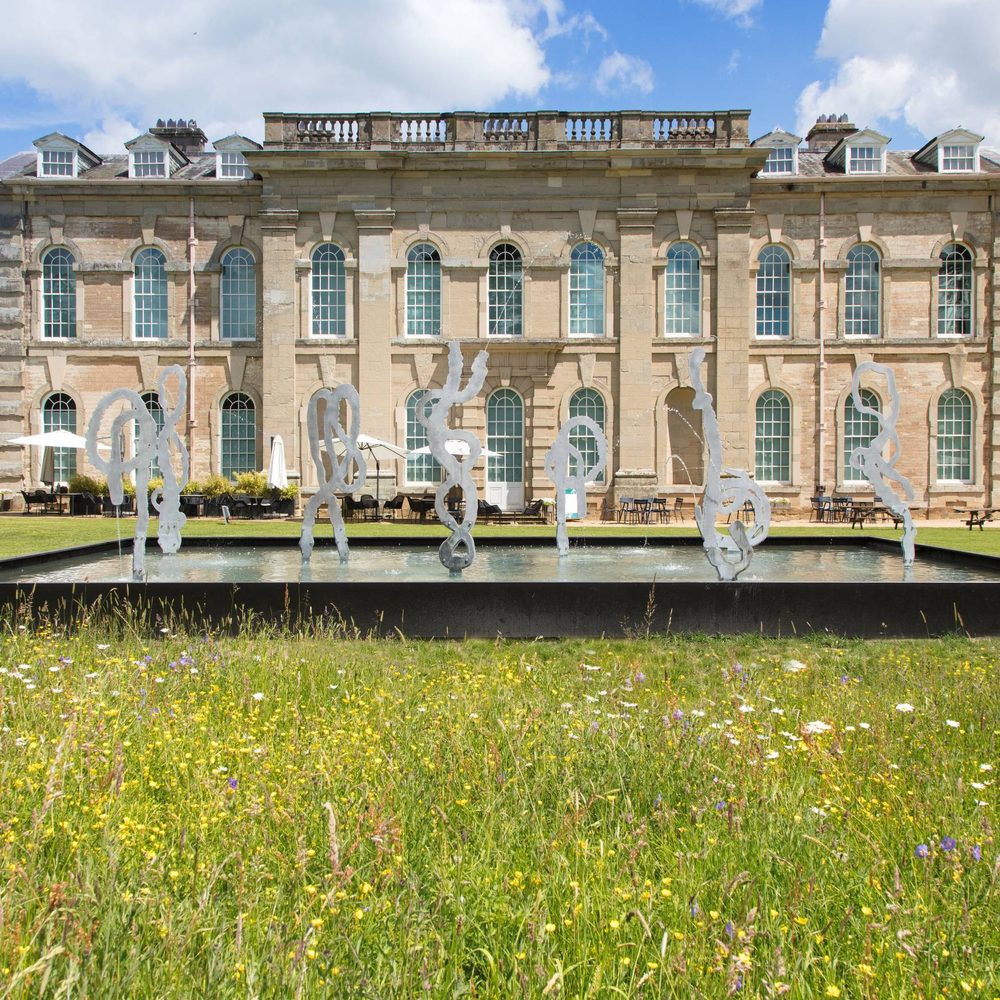
Opening Times
Wed – Sun: 10am-5pm
Mon and Tue: Closed, except bank holidays
Galleries are open 10.30am – 5pm
About the
Exhibition
Discover our incredible new sculpture park, where cutting-edge contemporary art meets historic landscape.
Wander among powerful works by celebrated artists from around the world, including a brand-new piece made just for us. Explore how these daring sculptures reimagine ideas of community, home, and utopia for the 21st century.
The sculpture park includes works from leading UK-based artists such as Sarah Lucas (b.1962), who often uses ordinary objects to challenge sex, class and gender, Permindar Kaur (b.1965), who commonly uses domestic items to question the meaning of ”home”, and British-Ghanian artist Larry Achiampong (b.1984), whose work focuses on Pan African, future histories, speculative fiction and identity, both personal and communal. Work from international artists also features, including London-based French artist Nicolas Deshayes (b.1983) who explores organic and synthetic texture through his work, and Lithuanian artist Augustas Serapinas (b.1990), who draws on his country’s history and culture to produce works made from found material and borrowed objects.
Two legendary figures in sculpture also have their work featured. On display will be works by French-American artist Louise Bourgeois (1911-2010), best known for her monumental spider sculptures that feature in galleries worldwide, and Turner Prize-nominated British artist Helen Chadwick (1953-1996), who created works investigating ideas of gender and the body.
A significant part of the sculpture park is an ongoing series of invitations to artists to directly respond to the landscape at Compton Verney and produce and showcase work as a result. The first artist to do so, with a new commission, is Brazilian artist Erika Verzutti (b.1971), whose work can be found in major collections across the world.
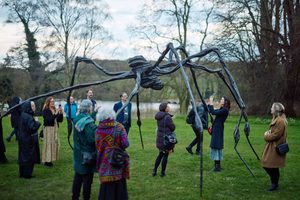
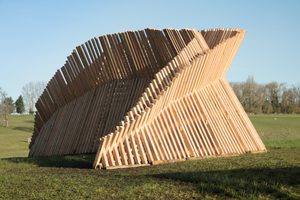
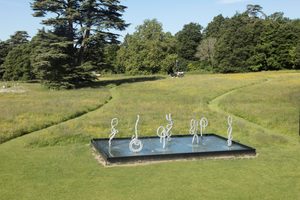
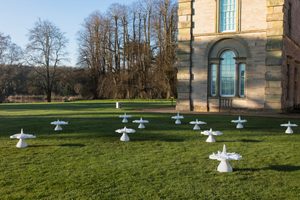
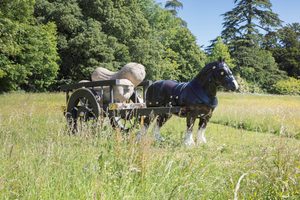
Sculpture in the Park Gallery
About
the Artists
Pan African Flag for the Relic Travellers’ Alliance forms part of Larry Achiampong’s Relic Traveller: Phase 1, a multi-disciplinary project manifesting in performance, audio, moving image and prose.
Presented here at Compton Verney, five flags look and stand guard out across the Capability Brown landscape. The design of each flag features 54 stars that represent the 54 countries of Africa and highlight the African diasporic identity. The colours green, black and red reflect its land, its people and the struggles the continent has endured, and the field of yellow gold represents a new day and prosperity.
Taking place across various landscapes and locations, Larry Achiampong’s Relic Traveller: Phase 1 project builds upon a postcolonial perspective informed by technology, agency and the body, and narratives of migration. This speculative project considers the current social and political climate of our time; especially the rise of nationalism within the global West and tensions surrounding moments such as the United Kingdom’s ‘leave’ Brexit vote in 2016 for example. Meanwhile, the African Union’s African passport programme (also established in 2016) points toward the potential opening of boarders across a unified African continent in the future.
Larry Achiampong (b. 1984, UK, British Ghanaian) is an artist, filmmaker and musician. He completed a BA in Mixed Media Fine Art at University of Westminster in 2005 and an MA in Sculpture at The Slade School of Fine Art in 2008. Achiampong was awarded the Stanley Picker Fellowship in Art and Design (2020), he was shortlisted got the Jarman Award (2018/2021) and received the Paul Hamlyn Award (2019) in recognition for his practice. Recent major solo projects include Genetic Automata (with David Blandy) at the Wellcome Collection, London (2023-24); Wayfinder at Turner Contemporary Margate/MK Gallery Milton Keynes, and BALTIC Centre for Contemporary Art, Gateshead (2022-2023); Liverpool Biennial (2021); Relic Traveller: Where You and I Come From, We Know That We Are Not Here Forever, Phi Foundation for Contemporary Art, Montreal (2021); When the Sky Falls, John Hansard Gallery, Southampton (2020); Pan African Flag For The Relic Travellers Alliance & Relic Traveller, Phase 1, 019, Ghent (2019); Dividednation, Primary, Nottingham (2019).
Spider (1996) is a bronze sculpture by the artist Louise Bourgeois. This iconic sculpture, which depicts a spider, picks up the theme of the arachnid that Bourgeois had first contemplated in a small ink and charcoal drawing in 1947. Spider is over seven metres wide and over three metres high and is part of a series of Spider sculptures made during the 1990s that explored ideas of female identity and the role of the mother. The Spider is a powerful motif within her work that questions the conventional roles of women in society with the industrious spider alluding to Bourgeois mother, with metaphors of spinning, weaving, nurture and protection.
Piss Flowers is considered to be one of Helen Chadwick’s most important sculptural works. Comprised of eleven bronze sculptures that resemble flowers, enamelled white to imitate plaster, the making of the sculptures required the strategic use of the other material invoked in their name.
During a residency at the Banff Arts Centre, Canada in 1991, Chadwick and her partner David Notarius made daily visits to snowbound locations. There they would place a flower-shaped metal mould onto a mound of snow, taking turns to urinate into it. They then poured plaster into the shapes created. From these casts, bronze versions were made and mounted onto pedestals resembling bulbs. The downward path of the hot urine through snow is inverted to form a flower reaching upwards.
Crucially the work inverts a gendered symbolism, for it is Chadwick’s urination that yields the phallic pistil at the centre of each Piss Flower. The artist saw these works as romantic insofar as they are a “metaphysical conceit for the union of two people expressing themselves bodily.”
Large cast aluminium fountains take the form of undulating upright forms, knotting or coiling like digestive tracts on the surface of a vast custom-built basin. Their bloated silhouettes are animated by a graceful and silent choreography, like synchronised swimmers expressing the visceral joys of a mute existence. They spit, rummage, piss and ejaculate, seeming to celebrate the fertility of aquatic and subterranean worlds. This delicate, subdued ballet contrasts with the powerful roar of the waterfall that crashes at the foot of the building. The work takes it place on the original 17th century garden where there would have been a fountain and marks a small prod at the establishment in its humorous form.
Overgrown House (2020) a large structural outline of an overgrown house made from black galvanised steel by Permindar Kaur. With a series of grass-like offshoots giving the house a fairytale-like appearance, the structure evokes part abandoned house as well as the potential for growth. It follows from a series of works that the UK artist has created featuring houses and the home, often using items from the domestic and childhood arena. Amidst the landscape of Compton Verney, Kaur´s sculpture is fluid and seems to transform before our eyes – it is both a private and public space that sprouts and lives yet is also uncannily uniform and controlled ongoing themes within her practice that ask where and what is home?
Sarah Lucas’ sculpture Perceval – a life-size bronze horse and cart – presents a large-scale replica of a traditional china ornament, of the kind that took pride of place on many British mantelpieces forty years ago. Scaled up, the Clydesdale horse is powerful and majestic while offering an unthreatening sense of pastoralism and stolid reliability. The proudly-fashioned cart houses two cast concrete marrows: off-scale symbols of phallic fertility. These giant vegetables are cast in cement, moving the knick-knack replica away from the realm of kitsch, and offsetting the smooth finish of the bronze with a rugged and contingent quality. Titled after a Knight of King Arthur’s Round Table, Perceval reflects a fascination for Englishness evident in much of Lucas’s work, becoming an object for public display that is generous, democratic, familiar and accessible.
Standtune is a sculpture developed at the Gotland Museum in Visby, a small island off the coast of Sweden. Standtune is a local and ancient fencing technique developed for defence purposes in Sweden. Repurposing this technique for this sculpture, Serapinas questions who has the power to decide on our common cultural heritage and what should be in a museum’s collection and exhibition? Which objects should stay on one or the other side of the “fence” and thus border?
Sensuous and tactile, Verzutti’s sculptures often seem to sit outside of period and place, conjuring relics or archaeological finds. Realised in bronze, concrete and papier mâché, they draw from a range of sources – from vegetables and household objects to newspaper clippings and imagery found online. They take a playfully omnivorous approach to art history, quoting and reimagining works that stretch from Brancusi to Brazilian modernism, or from Picasso back to the palaeolithic.
For Compton Verney, Verzutti releases a new work as part of her long standing Venus series which references the Venus of Willendorf. Discovered in Austria at the beginning of the 20th century, this artefact was made around 25,000 years ago, and is often regarded as the mother of all sculpture. Here, Venus reclaims the female gaze, positioning Venus as a powerful figure in the landscape.

Image: Sculpture in the Park- Louise Bourgeois, Spider. © Compton Verney, photo by Jamie Woodley. Louise Bourgeois’s art is © The Easton Foundation DACS, London












